Carbon-source-dependent expression of the PalkB promoter from the Pseudomonas oleovorans alkane degradation pathway
- PMID: 9748457
- PMCID: PMC107560
- DOI: 10.1128/JB.180.19.5218-5226.1998
Carbon-source-dependent expression of the PalkB promoter from the Pseudomonas oleovorans alkane degradation pathway
Abstract
Pseudomonas oleovorans GPo1 can metabolize medium-chain-length alkanes by means of an enzymatic system whose induction is regulated by the AlkS protein. In the presence of alkanes, AlkS activates the expression of promoter PalkB, from which most of the genes of the pathway are transcribed. In addition, expression of the first enzyme of the pathway, alkane hydroxylase, is known to be influenced by the carbon source present in the growth medium, indicating the existence of an additional overimposed level of regulation associating expression of the alk genes with the metabolic status of the cell. Reporter strains bearing PalkB-lacZ transcriptional fusions were constructed to analyze the influence of the carbon source on induction of the PalkB promoter by a nonmetabolizable inducer. Expression was most efficient when cells grew at the expense of citrate, decreasing significantly when the carbon source was lactate or succinate. When cells were grown in Luria-Bertani rich medium, PalkB was strongly down-regulated. This effect was partially relieved when multiple copies of the gene coding for the AlkS activator were present and was not observed when the promoter was moved to Escherichia coli, a heterologous genetic background. Possible mechanisms responsible for PalkB regulation are discussed.
Figures
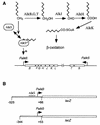
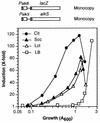

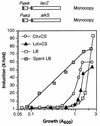

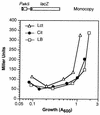
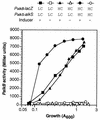
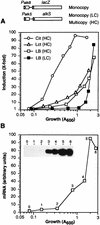
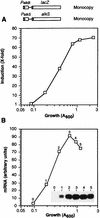
Similar articles
-
Role of the alternative sigma factor sigmaS in expression of the AlkS regulator of the Pseudomonas oleovorans alkane degradation pathway.J Bacteriol. 1999 Mar;181(6):1748-54. doi: 10.1128/JB.181.6.1748-1754.1999. J Bacteriol. 1999. PMID: 10074066 Free PMC article.
-
The PalkBFGHJKL promoter is under carbon catabolite repression control in Pseudomonas oleovorans but not in Escherichia coli alk+ recombinants.J Bacteriol. 1999 Mar;181(5):1610-6. doi: 10.1128/JB.181.5.1610-1616.1999. J Bacteriol. 1999. PMID: 10049394 Free PMC article.
-
A positive feedback mechanism controls expression of AlkS, the transcriptional regulator of the Pseudomonas oleovorans alkane degradation pathway.Mol Microbiol. 2000 Feb;35(4):791-9. doi: 10.1046/j.1365-2958.2000.01751.x. Mol Microbiol. 2000. PMID: 10692156
-
Genetics of alkane oxidation by Pseudomonas oleovorans.Biodegradation. 1994 Dec;5(3-4):161-74. doi: 10.1007/BF00696457. Biodegradation. 1994. PMID: 7532480 Review.
-
Bioconversions of aliphatic compounds by Pseudomonas oleovorans in multiphase bioreactors: background and economic potential.Trends Biotechnol. 1990 Feb;8(2):46-52. doi: 10.1016/0167-7799(90)90133-i. Trends Biotechnol. 1990. PMID: 1366497 Review.
Cited by
-
Regulation of tetralin biodegradation and identification of genes essential for expression of thn operons.J Bacteriol. 2004 Sep;186(18):6101-9. doi: 10.1128/JB.186.18.6101-6109.2004. J Bacteriol. 2004. PMID: 15342579 Free PMC article.
-
The Pseudomonas putida Crc global regulator controls the expression of genes from several chromosomal catabolic pathways for aromatic compounds.J Bacteriol. 2004 Mar;186(5):1337-44. doi: 10.1128/JB.186.5.1337-1344.2004. J Bacteriol. 2004. PMID: 14973036 Free PMC article.
-
Metabolic and Evolutionary Insights in the Transformation of Diphenylamine by a Pseudomonas putida Strain Unravelled by Genomic, Proteomic, and Transcription Analysis.Front Microbiol. 2018 Apr 6;9:676. doi: 10.3389/fmicb.2018.00676. eCollection 2018. Front Microbiol. 2018. PMID: 29681895 Free PMC article.
-
The Escherichia coli rhaSR-PrhaBAD Inducible Promoter System Allows Tightly Controlled Gene Expression over a Wide Range in Pseudomonas aeruginosa.Appl Environ Microbiol. 2016 Oct 27;82(22):6715-6727. doi: 10.1128/AEM.02041-16. Print 2016 Nov 15. Appl Environ Microbiol. 2016. PMID: 27613678 Free PMC article.
-
Catabolite repression control by crc in 2xYT medium is mediated by posttranscriptional regulation of bkdR expression in Pseudomonas putida.J Bacteriol. 2000 Feb;182(4):1150-3. doi: 10.1128/JB.182.4.1150-1153.2000. J Bacteriol. 2000. PMID: 10648543 Free PMC article.
References
-
- Ausubel F M, Brent R, Kingston R E, Moore D D, Seidman J G, Smith J A, Struhl K, editors. Current protocols in molecular biology. New York, N.Y: John Wiley & Sons, Inc.; 1989.
-
- Bachmann B J. Derivations and genotypes of some mutant derivatives of Escherichia coli K12. In: Neidhardt F C, Ingraham J L, Low K B, Magasanik B, Schaechter M, Umbarger H E, editors. Escherichia coli and Salmonella typhimurium: cellular and molecular biology. Washington, D.C: American Society for Microbiology; 1987. pp. 1191–1219.
-
- Bagdasarian M, Lurz R, Rückert B, Franklin F C H, Bagdasarian M M, Frey J, Timmis K N. Specific-purpose plasmid cloning vectors. Broad host range, high copy number, RSF1010-derived vectors, and a host-vector system for gene cloning in Pseudomonas. Gene. 1981;16:237–247. - PubMed
Publication types
MeSH terms
Substances
LinkOut - more resources
Full Text Sources
Other Literature Sources

